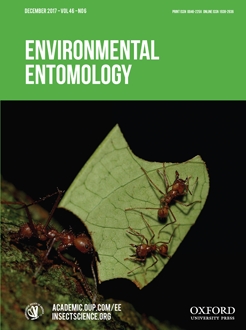Japanese barberry (Berberis thunbergii de Candolle; Ranunculales: Berberidaceae) is an exotic invasive shrub that escaped cultivation in the United States and is now permanently established in many eastern and midwestern states. This study examined the long-term impacts of Japanese barberry management on blacklegged tick (Ixodes scapularis Say; Acari: Ixodidae) abundances and associated prevalence of Borrelia burgdorferi (Johnson, Schmid, Hyde, Steigerwalt, and Brenner; Spirochaetales: Spirochaetaceae), the etiologic agent of Lyme disease. At six locations across Connecticut, adult I. scapularis were sampled for up to 10 yr. At each location, we sampled an area where barberry infestations were unmanipulated, adjacent areas where barberry was virtually nonexistent, and areas where barberry was managed utilizing a variety of techniques. Barberry management reduced B. burgdorferiinfected adult I. scapularis (BBIAIS) abundances (191/ha ± 64 SE) over 6 yr to statistically indifferent from that of no barberry areas (140/ha ± 47 SE; P = 0.080) and significantly less than intact barberry stands (458/ha ± 80 SE; P = 0.026). Over 9 yr, BBIAIS abundances in managed barberry remained lower than intact barberry stands (P = 0.037), but increased to be significantly greater than no barberry areas (P = 0.007) as cover increased over time. Longer-term data further document that Japanese barberry infestations are favorable habitat for I. scapularis. Control of Japanese barberry and other invasives should be at least on a 5-yr rotation to maintain low levels of invasive cover and eliminate humidity refugia to expose juvenile I. scapularis to more hostile environmental conditions in the interest of public health.
How to translate text using browser tools
26 September 2017
Long-Term Effects of Berberis thunbergii (Ranunculales: Berberidaceae) Management on Ixodes scapularis (Acari: Ixodidae) Abundance and Borrelia burgdorferi (Spirochaetales: Spirochaetaceae) Prevalence in Connecticut, USA
Scott C. Williams,
Megan A. Linske,
Jeffrey S. Ward
ACCESS THE FULL ARTICLE
It is not available for individual sale.
This article is only available to subscribers.
It is not available for individual sale.
It is not available for individual sale.

Environmental Entomology
Vol. 46 • No. 6
December 2017
Vol. 46 • No. 6
December 2017
humidity
invasive
Japanese barberry
Lyme disease
management




